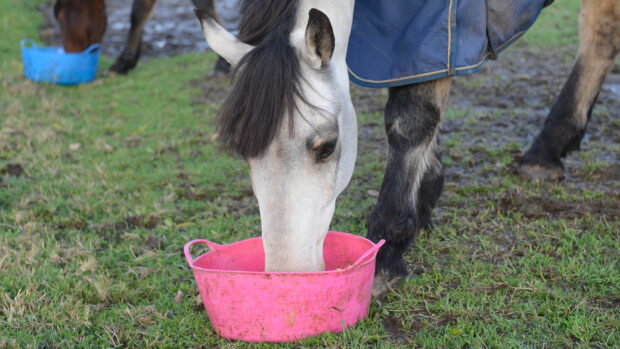If your horse appears to be losing weight during the winter months, you need to devise a plan for weight gain based on his workload, breed and individual circumstances, says independent nutritionist Pamela Kinslow.
Pamela advises that owners estimate their horse’s ideal weight and gradually increase the dietary energy intake by 10-20% up to his goal weight. For most horses, this would equate to an additional 1-2 scoops of hard feed (spread over several meals), or 2-3 sections of hay a day.
It is important to bear in mind that the horse is a natural trickle-feeder, rather than a meal-feeder, and mimicking this pattern will protect his digestive integrity.
“For any horse, the amount of feed, including concentrates and fibre, should not exceed about 2-3kg (4.5-6.5lb, or about 2-3 feed scoops) per meal,” Pamela explains.
“The volume of the meal can be increased through the addition of a chop or chaff, which will slow consumption and avoid the small stomach being overloaded with concentrate feeds. Most horses will eat to appetite, but it is still preferable to split feeds and forage into as many meals as is practical, so that a fairly constant supply of food is available.”
Choosing the right feed
Forages
The process of digesting fibre creates heat – therefore, high-fibre forages such as hay, haylage and fibre chops are excellent winter choices. These feeds are digested by the microflora in the hindgut through a process of fermentation, and the heat that is released as a result actually warms the horse from the inside.
High-fibre calories
High-fibre sources of calories include sugar beet pulp, alfalfa chop or pellets, and dehydrated grass chop or pellets. Although high in energy, these feeds are generally less heating than the majority of cereals and compound feeds.
Oil
Oil is the most fattening feed available, giving three times the energy of cereals, but with the advantage of being non-heating. If split between feeds, up to a pint of soya or corn oil can be fed per day, but this should be introduced gradually. Bear in mind that feeding oil will increase the need for the antioxidant vitamin E to replace muscle cells, which can be damaged by high-fat diets.
Haylage
Haylage is generally more fattening than dried hay, as in spite of its higher water content (30-40 per cent), it is conserved grass, which is usually cut when it is more energy-dense. To provide adequate fibre, therefore, haylage needs to be fed in greater quantities than dried hay, particularly if it makes up a small proportion of the diet, in conjunction with concentrates.
Cereals and compound feeds
Naked oats provide high energy in a concentrated form and are also highly digestible. Cereals that have been cooked or micronised, such as flaked maize or extruded barley, are also more digestible than unprocessed cereals, and therefore more conditioning. Coarse mixes are usually higher in sugar and energy than cubes.
Boiled barley and boiled linseed
These cooked seeds are a useful addition to the winter diet. According to Pamela, feeding boiled grains is somewhat “out of fashion”, but she says barley and linseed are excellent conditioning feeds.
Once the horse has reached its desired weight, gradually return to a maintenance programme and continue to monitor its weight throughout the year.
Weight gain plan
- Condition-score and physically check the horse’s coverage with your hands
- Maintain worming and dentistry programmes to ensure a good quality of life
- Rug your horse adequately to maintain warmth
- Choose fattening feed types
- Work out a weight gain diet
- Encourage correct utilisation of feed
- Ensure long-term dietary health, with the use of a maintenance diet



